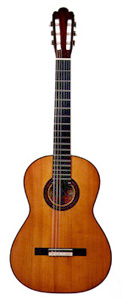

Antonio De Torres Jurado (June 13, 1817 La Cañada de San Urbano, Almería - November 19, 1892 La Cañada de San Urbano, Almería) is as revered among guitarists as Stradivarius is revered among violinists. His work established the shape, design, and construction of the modern Classical guitar.
Antonio de Torres was the son of Juan Torres, a local tax collector, and Maria Jurado. As was common, when he was 12 he started an apprenticeship as carpenter. In 1833, a dynastic war broke out, and soon after Torres was conscripted into the army. Through his father's machinations, young Antonio was dismissed as medically unfit for service. As only single men and widower's without children were draftable, his family pushed Torres into a hastily arranged marriage to the 13 year old daughter of a shopkeeper. And, in 1835 Antonio wed Juana María López. Children soon followed: a daughter in 1836; and another in 1839, a third in 1842 who died a few months later. His second daughter also died. And, in 1845 his wife died at the age of 23 of tuberculosis. These were difficult years for Torres, he was often in debt, and looking for more lucrative forms of employment.
Although there is some debate as to who taught Torres, one theory is that some time around 1842, Torres may have gone to work for José Pernas in Granada, rapidly learning to build guitars. He soon returned to Sevilla, and opened a shop on the calle Cerrageria No. 7 that he shared with Manuel Soto y Solares. Although he made some guitars during the 1840s, it was not until the 1850s on the advice of the renowned guitarist and composer Julián Arcas, that Torres made it his profession, and he began building in earnest. Julian Arcas offered Torres advice on building, and their turned collaboration Torres into an inveterate investigator of the guitar construction. Torres reasoned that the soundboard was key. To increase its volume, he made his guitars not only larger, but fitted them with thinner, hence lighter soundboards that were arched in both directions, made possible by a system of fan-bracing for strength. To prove that it was the top, and not the back and sides of the guitar that gave the instrument its sound, in 1862 he built a guitar with back and sides of papier-mâché. (This guitar resides in the Museu de la Musica in Barcelona, unfortunately it is no longer playable). Another of his experiments --perhaps a better description would be a display of his craftsmanship-- was a guitar made like a Chinese puzzle that could assembled without glue, and disassembled would fit in a shoe box.
Torres was a secretive man, and so had no disciples, but in a letter to his friend Juan Martinez Sirvent explained:
"my secret is one you have witnessed many times, and one that I can't leave to posterity, because it must with my body go to the grave, for it consists of the tactile senses in my finger pads, in my thumb and index finger that tell the intelligent builder if the top is or is not well made, and how it should be treated to obtain the best tone from the instrument."
In 1868, Torres married again, wedding Josefa Martín Rosada. Shortly after, Torres met Francisco Tarrega for the first time. Tarrega then a kid of seventeen had come to Sevilla from Barcelona to buy a Torres from the maker of Julían Arcas' instrument. Torres offered him a modest guitar he had in stock, but on hearing him play, offered him a guitar he had made for himself a few years before. About 1870, Don Antonio then in his 50's closed his shop in Sevilla, and moved back to Almería where he and his wife opened up a china and crystal shop on the calle Real. About five years latter, Don Antonio began his "second epoch" as he refers to it on the labels of his guitars, building part-time when not busy in the china shop. After the death of his wife, Josefa, in 1883, Torres began to devote increasing amounts of time to building making some 12 guitars a year until his death.
Torres guitars are divided into two epochs. The first, belonging to Sevilla from 1852-1870; the second, being the years 1871-1893 in Almería. The guitars Torres made so superior to those of his contemporaries that their example changed the way guitars were built, first in Spain , and then in the rest of the world. Although they are not particularly loud by modern standards, they have a clear, balanced, firm and rounded tone, that projects very well. His guitars were not only widely imitated and copied, but as he never signed his guitars, and only numbered those from his second epoch, over the years many fakes Torres have been made, some made by well-known and expert makers.